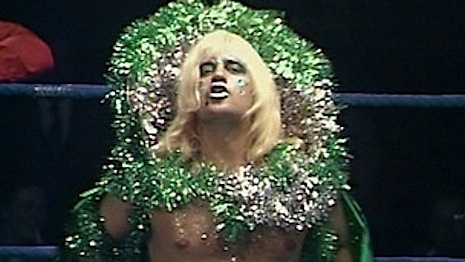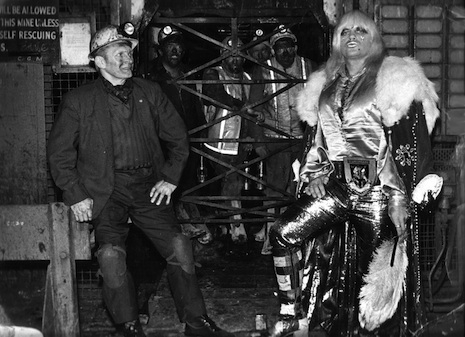
In Britain during the 1970s live wrestling matches were broadcast every Saturday afternoon on the ITV channel. Millions of fans tuned in to watch such legendary British wrestlers as Mick McManus, Jackie Pallo, Giant Haystacks and Big Daddy. These men were working class heroes—no nonsense traditional wrestlers in trunks and boots. Though they looked like your Dad—a bit a chubby, with a liking for beer—in the ring they were ruthless. Each was a master of a particular wrestling technique with which they showed off their athletic prowess.
Then one Saturday there arrived Adrian Street—a peroxide blonde, in lipstick and mascara, nail polish and pantyhose. He was the most glamorous wrestler on the planet. Street was camp, outrageous, a glam rock wrestling superstar who dispatched his opponents without chipping a fingernail. He was the “merchant of menace,” the “sweet transvestite with a broken nose.” A herald of the social and sexual changes happening at full tilt across the country. He was loved and loathed in equal measure—an older generation feared what he represented; a younger generation embraced it.

Each week Adrian turned up in more elaborate costumes, more glittering makeup and a selection of moves that brought the crowds to their feet. His trademark was to kiss his opponent. While they reeled from the shock of being kissed by another man, Adrian flattened them with a forearm smash, a drop kick, or his favorite the sleeper hold.
Adrian Street was born into a mining family in Brynmawr, Wales in 1940. As a child he fantasized about running away with a tribe of Native American Indians. He wandered neighboring fields dreaming he was Tarzan and picking bluebells to give to his mother. In his teens he started body-building and briefly worked with his father down the mines. He then moved to London where he began his wrestling career in 1957. He was trained by Chic Osmond and fought under the name Kid Tarzan. During his time in London Adrian had his first taste of bohemia life hanging out with artists and writers most notably Francis Bacon. By the late sixties, Adrian reinvented himself as the androgynous wrestler “The Exotic One.” He went on to fight an estimated 15,000 bouts over a seven decade career.

In 2010 the artist Jeremy Deller made a documentary on Adrian Street called So Many Ways To Hurt You. Deller had been inspired to make his film by a photograph of the wrestler.
I first became aware of [Adrian] through a photograph showing him with his father in 1973, which seemed to me possibly the most important photograph taken post-war. It encapsulates the whole history of Britain in that period – of our uneasy transition from being a centre of heavy industry to a producer of entertainment and services. It’s a rather bizarre and disturbing photograph, taken when Adrian went back to Wales, to the mine that he had worked in as a young man, to meet his father. Adrian’s still very much alive and still wrestling in Florida, where he has settled. He’s an incredible person, who has tremendous willpower and a great sense of his own worth. His story has an epic quality to it, he has basically reinvented himself for the late twentieth century.
As much of an influence as all the pop artists who liberated teenage minds during the 1970s, Adrian Street opened up a world of rich diversity to an older generation who had been shaped by the austerity and hardship of post-War Britain.
In the 1980s, Street became a star of the north American wrestling circuit. He moved to Florida and began a new career designing wrestling costumes. He fought his last bout in 2010.
Previously on Dangerous Minds
Classic British wrestling posters